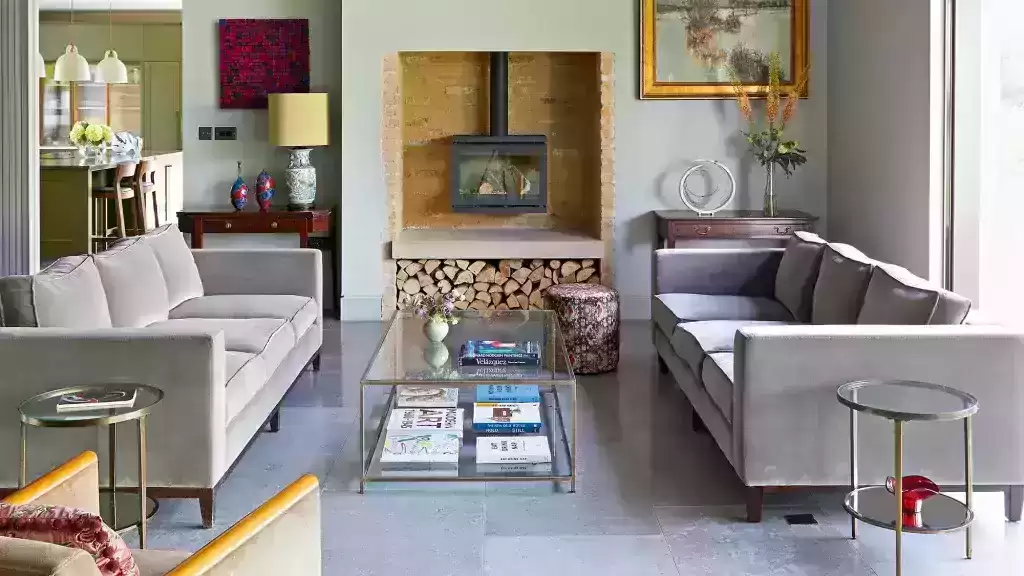Interior design using suitable materials for floors walls and furniture,
The overall impact in a design is more important than the specific device or element used, and the same is true for architectural components.

flooring
Basically, there are two types of flooring for interiors: those that form an integral part of the structure, and those that are applied after the structure is completed.
Interior designers working alongside architects have the opportunity to specify floors, such as slate, terracotta, stone, brick, concrete or wood.
But in most interiors, the floors are designed at a later stage and are often changed in the course of the life of the building.
Sometimes it may be possible to insert a heavy floor, such as terrazzo or stone, in a completed building or during remodeling.
But these materials, despite their beauty, tend to be very expensive as surface applications.
Resilient flooring materials that were commercialized in the late 20th century include asphalt, vinyl asbestos, linoleum, cork, and vinyl.
Cork, which is not a synthetic material, is handsome, but difficult to maintain and not exceptionally durable.
Basically, another flexible floor is tiles, which are excellent flooring materials that are economical and easy to maintain.
They can be given almost any look, which is a temptation manufacturers can’t resist.
When the tiles are plain, with good colors or textures, they are very attractive and suitable, but they are often made to imitate stone, brick, mosaic, or other materials, and the results are generally of a less pleasing nature.
vinyl
Pure vinyl is the most expensive of the resilient floors and the most tortured in terms of “design.”
Vinyl is also the softest, most flexible and easy-to-maintain type of tile.
Asphalt tiles are the least expensive and therefore the most widely used resilient flooring, although they are very fragile and rough underfoot.
Vinyl asbestos is somewhat softer underfoot and, because it is grease resistant, is easier to maintain than asphalt, but is generally more expensive.
Finally, Al-Misham, whose price ranges between asphalt and pure vinyl flooring, is strong and suitable for heavy-duty uses.

walls
Each wall is a material in itself, and ideally, there is no need for covering over any material,
if used properly.
Some of the elegant buildings erected since the 1960s have used concrete in its natural texture – showing the molds left by the woodwork as a conscious expression of the material.
For example, interior brick walls are considered beautiful and highly desirable.
However, many older homes have layers of plaster,
paint or wallpaper over the attractive brickwork.
It is not unusual for a decorative detail or device to survive long after the actual cause of it has disappeared.
Wall panels have been popular for hundreds of years, and in fact,
the natural wood texture adds warmth and elegance.
The only way craftsmen in earlier periods could use planks was through frames (ladders and rails) or hollows,
Because the planks were made of solid wood and had to be cut into tight dimensions in order to prevent warping and shrinkage.
Out of this need, beautiful details of moldings, carved details,
and carefully proportioned panels were developed.
While a similar art developed somewhat later in plaster,
It is clear that the costs and methods of building in the twentieth century seldom allow for real quality in the detailing of the panels or the highly decorated stucco,
And this kind of imitation design would not be appropriate in a modern building.
planks
But chipboard and plywood in many beautiful veneers are readily available and provide a wide range of beautiful wall surfaces.
Albeit pricey, for important spaces.
On the other hand, inexpensive, prefabricated plywood is often used as a finishing material for basement,
recreation, or utility rooms in many homes in the United States.
Fake moldings have been used,
with printed moldings or panels or with any of the countless imitations of wall cladding materials,
From brick wallpaper to artistically poor wallpaper,
this is the kind of decoration a good designer avoids.
However, not every interior should be a simple space devoid of anything but natural walls.

Furniture
For the average person, furniture is the most important aspect of interior design.
As it is an important design element for professionals as well,
This is because it is the most personal product that connects the human being to the building.
It is also personal because it can be moved from one home to another and
handed down from generation to generation,
and furniture often takes on an important sentimental value.
Accessories are more personal, but less important to the overall effect of the interior,
because they are by nature smaller than the furniture.
Almost anything people own or collect can be called an accessory.
Including functional objects, such as ashtrays, and decorative objects, such as porcelain,
glass, or ceramics.
Although there were some very sophisticated furniture in ancient Egypt,
However, the use of furniture was rare during the Middle Ages and only became important in the West during the Renaissance.
For more architectural news
التصميم الداخلي باستخدام المواد المناسبة للأرضيات والجدران والأثاث


 العربية
العربية